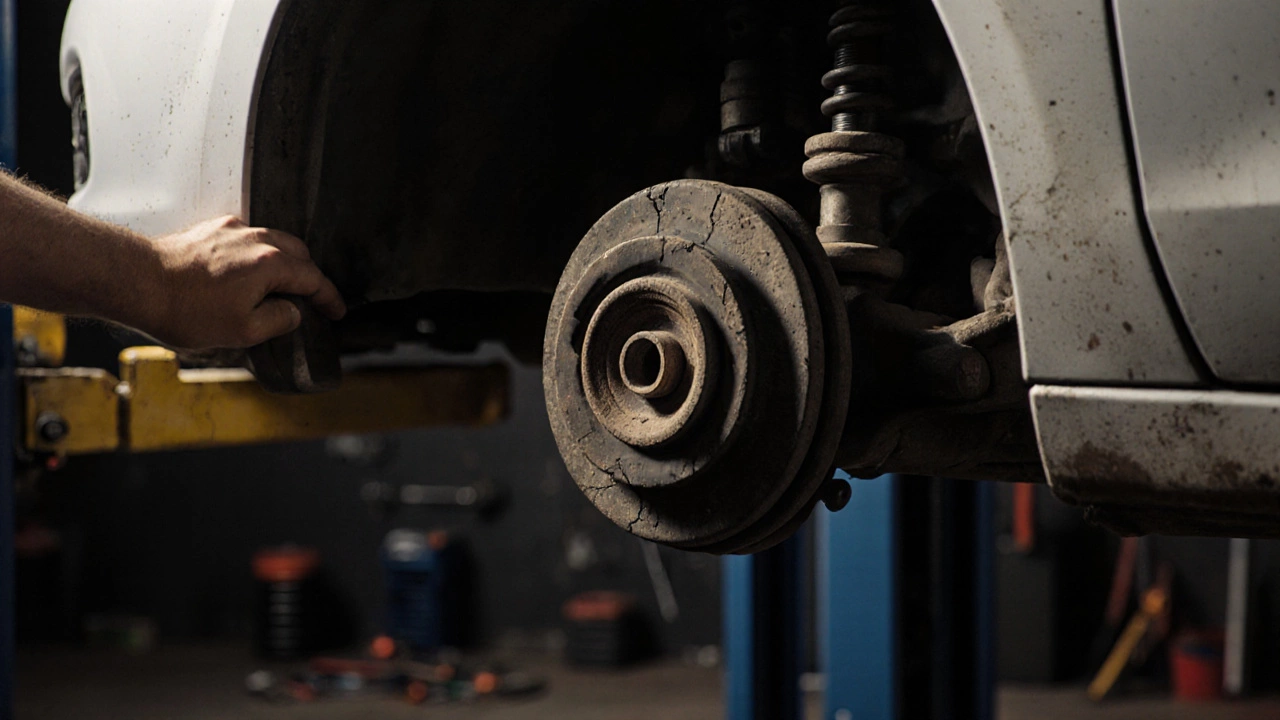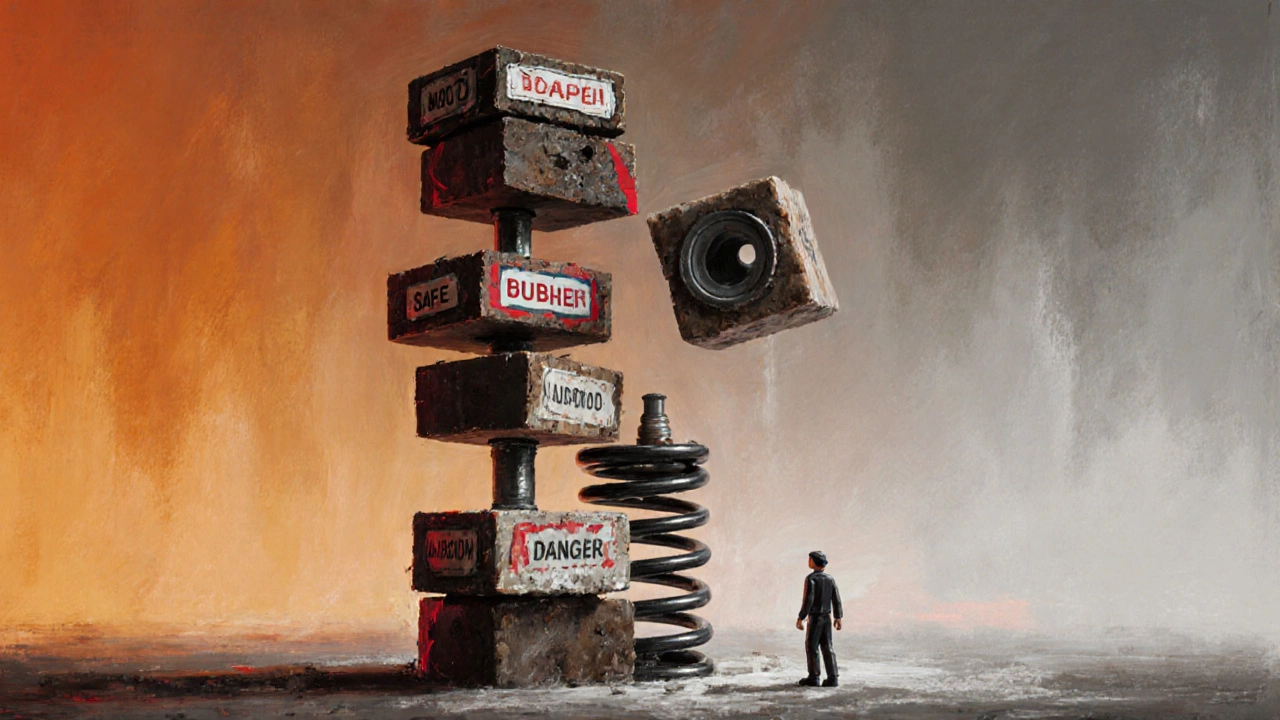 Nov, 17 2025
Nov, 17 2025
Suspension Noise Diagnostic Tool
Identify what the noises from your car's suspension might indicate and get actionable advice for repairs. Select the noise you're hearing to learn more about the potential cause and recommended next steps.
If your car suddenly starts making strange noises over bumps, potholes, or even smooth roads, your suspension might be the culprit. It’s not just about ride comfort-noises from a failing suspension system are warning signs you can’t ignore. These sounds don’t always mean a full replacement, but they do mean it’s time to take a closer look before things get worse-or more expensive.
Clunking or Thumping Over Bumps
The most common sound you’ll hear from a bad suspension is a loud clunk or thump when you hit a bump or go over a speed bump. This isn’t just the tire hitting the wheel well. It’s metal hitting metal inside the suspension.
Usually, this comes from worn control arm bushings, broken sway bar links, or loose ball joints. In older cars-especially ones with over 100,000 km-the rubber bushings dry out, crack, and lose their grip. When that happens, the metal parts inside the joint slam together every time the suspension moves. You’ll hear it most clearly when going over uneven surfaces or turning slowly out of a driveway.
Test it: Park on level ground, push down hard on one corner of the car, then let go. If you hear a clunk or feel extra bounce, that’s your suspension telling you something’s loose. Don’t wait until it falls apart.
Knocking or Popping During Turns
When you turn the steering wheel and hear a sharp knock or popping noise, especially from the front wheels, it’s often the CV joints or strut mounts failing.
CV joints connect the axle to the wheel. If the rubber boot protecting them is torn, dirt gets in and grease leaks out. That leads to metal-on-metal grinding. The noise gets louder as you turn more sharply, and you might also feel vibration in the steering wheel.
Strut mounts can also make popping sounds. These are the rubber-and-metal components that hold the top of the shock absorber to the car’s body. When they wear out, they don’t absorb the twisting motion of the suspension during turns. The result? A loud, metallic pop that sounds like something’s breaking.
Squeaking or Creaking at Low Speeds
A high-pitched squeak or creak when driving slowly over bumps or turning is usually a sign of dry or rusted components-not always broken, but definitely in need of attention.
Common culprits: worn shock absorber bushings, dry strut bearings, or rusted springs. In places like Hamilton, where winters mean road salt and moisture, rust builds up fast on coil springs and suspension arms. The metal doesn’t move smoothly anymore, so it squeaks every time it flexes.
Try this: Spray a little penetrating oil (like WD-40 Specialist) around the top of the shock absorbers and the spring coils. Drive slowly over a bump. If the squeak goes away temporarily, you’ve found the source. It’s not a fix-but it tells you exactly where to look next.
Rattling Sounds from the Wheel Well
If you hear a rapid rattle-like loose change in a tin can-when driving over rough roads, it’s probably something physically loose.
Check the sway bar end links. These small metal rods connect the sway bar to the control arms. They have rubber bushings and metal pins that wear out. When they do, the pin rattles inside the link. It’s a common issue on Honda Civics, Ford F-150s, and Toyota Camrys after 80,000 km.
Also check the brake caliper bolts. A loose caliper can rattle against the rotor, especially if you’ve had recent brake work. It’s easy to miss, but the noise is very distinct: fast, high-pitched, and rhythmic with wheel rotation.

Humming or Drone at Highway Speeds
A low, constant hum or drone that gets louder as you speed up might sound like a tire issue-but it could be worn wheel bearings or failing shocks.
Wheel bearings are inside the hub, right behind the brake rotor. When they wear, they don’t just get noisy-they get hot. A bad bearing will hum steadily at 60 km/h and get louder at 90 km/h. If you turn left and the noise gets louder, the right bearing is likely bad. Turn right? Left bearing’s failing.
Shocks that are completely worn out can also cause a low-frequency drone. They’re supposed to control spring movement. If they’re gone, the springs bounce uncontrollably, creating a rhythmic hum that feels like the whole car is vibrating. You’ll also notice the car feels floaty, and it takes longer to stop.
Why You Can’t Ignore These Sounds
Some people think suspension noises are just annoying. They’re not. They’re safety issues.
A broken ball joint can cause your wheel to detach while driving. A failed strut mount can make your steering feel loose or unresponsive. Worn shocks mean your tires don’t stay flat on the road during braking, increasing stopping distance by up to 20%-according to tests by the National Highway Traffic Safety Administration.
And it’s not just safety. A bad suspension wears out your tires faster. You’ll replace them every 20,000 km instead of 50,000 km. It also puts extra stress on your steering and braking systems. Fixing a $150 bushing now saves you $1,200 in other repairs later.
What to Do Next
Don’t guess. Don’t rely on YouTube videos alone. Take your car to a mechanic who specializes in suspension work.
Before you go:
- Write down exactly when you hear the noise: over bumps? during turns? at certain speeds?
- Try to describe the sound: clunk? squeak? rattle? hum?
- Check your tire pressure. Low pressure can mimic suspension noise.
- Look under the car (if safe) for obvious damage: torn boots, broken springs, leaking shocks.
A good shop will lift the car, inspect each component, and show you the worn parts. Ask them to explain what’s failing and why. If they say, ‘It’s probably fine,’ get a second opinion.

Common Mistakes People Make
Many drivers try to fix suspension noise with DIY spray lubricants. That might quiet a squeak for a week-but it won’t fix a broken part. You’re masking the problem, not solving it.
Others replace just one shock absorber. That’s a bad idea. Shocks wear evenly. Replacing only one side creates an imbalance. The car will pull to one side, and the new shock will wear out faster.
And don’t assume new parts mean a quiet ride. Cheap aftermarket shocks or bushings often fail within a year. Stick to OEM-spec parts or reputable brands like Monroe, KYB, or Bilstein.
When to Replace vs. Repair
Not every noise means a full suspension overhaul. Here’s a quick guide:
- Replace: Shocks, struts, control arms, ball joints, sway bar links (if worn or broken)
- Repair: Bushings (can be replaced individually), strut mounts (often replaced with the shock), wheel bearings (if the hub is still good)
Most mechanics will replace shocks and struts in pairs. It’s not optional-it’s standard practice. Same with ball joints and control arms on the same axle.
Prevention Tips
You can’t stop wear, but you can slow it down:
- Avoid potholes and rough roads when you can.
- Get your alignment checked every 20,000 km or after hitting a curb.
- Inspect suspension components during every oil change.
- Wash undercarriage in winter to remove road salt.
Simple habits like these can add years to your suspension system-and save you hundreds in repairs.